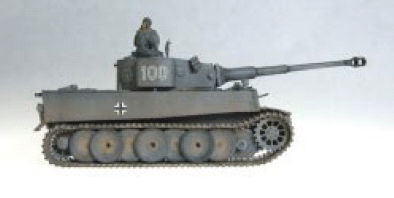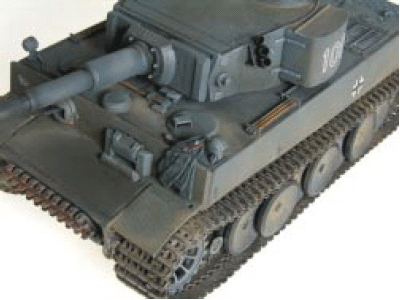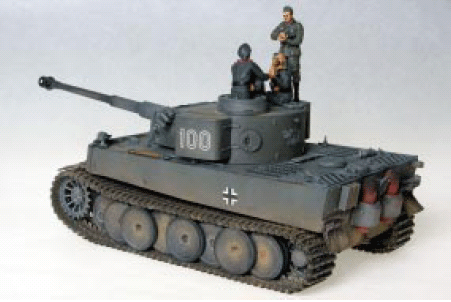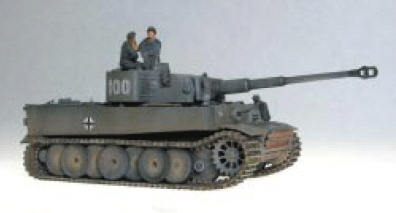
          
|
Dragon's Tiger I, Initial Production SpzAbt 502 3-in-1By Dave Edgerly, Originally published September 2005
First off, let me just say WOW!!!!!! This kit is wonderful. I know, the German Tiger is the Armor modelerís equivalent to the bf109 as far as really needing another new kit made of it but, HOLY COW, this puppy is a Grand Slam and in my humble opinion, puts Tamiya to shame. Most everyone knows what the Tiger was so I wonít go into detail about the real item. The initial version was deployed in late í42 to the Leningrad area of the Russian Front. OK, thatís it for the prototype data. There are plenty of references available if more tank specific data is required but this is a model review after all so here goes... Suffice it to say that there is a boatload of parts in this kitís box. (If you really care about or need to know the exact number it says on the box.) The materials are plastic, steel, brass and vinyl. Weíve got link-to-link, handed and already separated track, one turned aluminum and two plastic main gun tubes, three mantlets, brass and plastic 88mm rounds and spent casings, very accurate jerry cans (gas and water), two styles of the unique 502nd stowage boxes, fording gear, clear vision blocks and headlights, two sets of toolsóone with molded-on clamps and one without, three different pattern front fenders, glacis plate with and without fenders and even nifty alignment jigs for assembling the tracks. There is much more but you get the picture, Iím sure. Basically, you could build it all plastic or using the multimedia parts and either way youíll have a very full spares box with the left overs. Building is pretty easy but for a couple of minor glitches. Iíll mention them as I go along but Iíd like you to realize that they are probably modeler induced. The instructions are typical of Dragonóthorough and clear. The first thing youíll need to do is decide which SpzAbt 502 tank you want to build. Remember that only the 502nd had these initial production Tigers. Choose turret number 100 or 121 with or without snorkel equipment. I chose number 100 with the two side mounted stowage boxes but without the fording gear.
The hull is the first part tackled so thatís what I did. The instructions show how to make the suspension work so I tried it their way on four of the torsion bars and the result was a low rider Tiger. So, I lined them back up with the unaltered torsion bars and glued them in place. No harm, no foul. You could, of course, follow those instructions and glue them into whatever pose you wish and that is a nice feature. I suggest that the idler arm not be glued at this time as it helps tension the tracks. I opted for omitting the forward-most outer roadwheel as that looks so cool. I donít know if they ever removed it from Tiger 100 but itís my model so my commander had it removed to keep mud from jamming the drive sprocket. I didnít affix the wheels at this time for painting purposes. I then deviated from the instructions by not placing any of the upper deck stowage and glad that I didnít because here is my first glitch. The vertical plate (part F20) is glued to the upper deck piece (part K12) and this assembly is mounted to the lower chassis. Well, F20 has this forward jutting locking tab or some such that gets in the way of the horizontal glacis (part G19 or P8). If you do it in that order you will say some words that your spouse or children really shouldnít hear. My suggestion is to install the upper deck with the bow plate (F20) first and then the horizontal plate (G19 or P8). After that, things smoothed out and I followed the instructions again. As an aside, the multipart jack is very nice and can be posed extended if youíd like to put it in a maintenance scene. On the main gun assembly, I chose the aluminum barrel as it looks pretty darn good and you donít have seams to worry about. I suggest that you forgo the goofy spring action for your models mighty 88mm recoil. It is kind of stupid really. The breach assembly looks very convincing through the loaderís and commanderís hatches; even with figures installed. Those figures are not included in the kit but others are. The turret goes together well. I used the brass launcher tubes which are easy to assemble and look much better than the plastic due to the thin wall thickness. You could load them if you wish. It really is easy! Now, I didnít use the very nicely molded kit tracks only because I had some metal Fruilmodelissimo early Tiger track on hand. You really donít have to go that route as the kitís tracksdonít need much in the way of clean-upóonly minor ejector pin marks on the inner surface of each link. I think the clean-up and assembly times would be similar between the Fruil and the kit tracks. The kitís tracks are already separated and bagged by each side: Y = right and Z = left. Nifty, eh? But you know, those 20 pounds worth of metal tracks...drooooool! (Imagine Homer Simpson and Doughnuts.) Now, for the painting. Ca. 1942 pretty much means Panzer Gray, whatever that actually is. I chose the Polly S version as my basis. But first, primer is applied. I used Tamiya gray figure primer for the job. Next up is pre-shading with black. Once it has dried overnight, I come along with the Panzer Gray and a lighter version of the gray for panel fading. At this point, I gloss coated with Testors acrylic gloss and let dry overnight. (Actually about a week!) Next, I applied the decals. They are thin and lie down very well. I suppose that the white is a bit translucent but heck, it is, after all, a tank and the unit markings were usually field applications.
I used a burnt umber/Paynes gray wash and set it aside again to dry. Now for the accessories! The Jerry cans are for fuel and water you can tell by reading the markings molded into the parts. There is a photo-etched piece that is sandwiched between the plastic halves that represents the welded seam of the real can to great effect. Unfortunately, the alignment holes do not match so you must cut off the pins and use the old super glue. It all works out in the end and they look great. The turned brass 88mm ammo is of different functionality and have separate bases with the appropriate markings also. The plastic ammo does not by the way. The nifty bucket/pail is a nice addition and the only work required is to drop the bottom into it, level, glue and paint it your color of choice. I havenít quite figured where to hang it as this initial production model doesnít have a whole lot of practical spots to hang one. The two provided figures are of that funky vinyl that big D has decided to use now. But aside from the difficulty cleaning the mold seams and the attachment point nubs, they will glue together using the Testors glue in the black fine tip bottle. Tamiya figure primer sticks just fine also. I tried Vallejo paints exclusively on these figures. Since I canít paint figures worth a darn I really canít comment on their finer points but they cover very well as long as you shake the bottles for a fair-thee-well before trying to use them. The figures themselves are not Panzer crew but tourists! Theyíve got a movie camera and still camera instead of any weapons. So, I made them into propaganda photographers chatting up the two Tamiya Stug. III G crew members and dog. There are a pair of boots and two coats, one of which is a tankerís coat. Oh, the boots have hobnail detail on the soles, by the way.
Back to the Tiger and I covered all the vertical surfaces with dabs of all sorts of colors of oil paint. At this point my wife walks in, takes one look and walks out laughing her head off. I mean really! A flat clean brush moistened in Testors thinner is gently dragged from top to bottom until the colors all mix barely leave a trace of their existence. This gives a filtered effect and kills that uniform look to the gray. If you want more just do it again. The flat coat will lessen the effect so keep that in mind. I also did a bit of dry brushing using a very light aircraft gray. Since the Tiger is new, I think that the weathering would be light. Now the whole tank except for the tracks was flat coated using Testors acrylic flat. OK, here come the Fruil tracks. I cleaned them up and assembled 96 piece per side track runs. They arenít really that long but I wanted more than enough to start with for peace of mind. I then soaked them in vinegar for 24 hours. After they (Tiger One continued) were dry, I brushed on Blacken It and they looked pretty darn good. I then painted with a black and earth mixture, dry brushed with a dessert tan and hit all the cleats and guide teeth with a medium sanding stick followed by a fine sanding stick to bring out the shine of used metal. Finally, for the tracks anyway they were adjusted for fit and permanently attached to the Tiger.
At this point my courage was assailed by the collection of MIG pigments Iíve been collecting. Scary indeed but I had to try them. Not too long ago I noticed that Kingís Hobbies had a how-to clinic on the use of this product given by John Seaman so I thought Iíd show up and listen for a change. It was very good and it gave me the courage to try it. A little goes a long way so take your time and make sure that you use completely dry brushes. They donít have to be pretty but they MUST be dry. You do not have to apply another flat coat if youíre not going to play with the tank on the floor but if you do flat again, remember that it will lessen the affect of the pigments. Experiment on scrap plastic before you do anything to the model. So I added to the figures some refreshments for the soldiers and dog and draped the tankerís jacket over a thumbprint I left on the bow. Tiger 100 will be in a diorama with a Kubelwagen from a Panzer Propaganda Company and a couple more figures that will be called: ďOne more for the folks back homeíĒ Finally, I suggest that you ignore the fact that this is a Tiger tank and key in the fact that it is a joy to build this model. BUY IT AND BUILD IT!!! I say again: Do not just toss this one into the ďIíll build it somedayĒ black hole. I wonder if the Academy interior will fit in the next oneÖhmmmmm?
|
© Copyright 2010, Austin Scale Modelers Society (ASMS)





